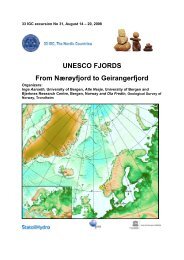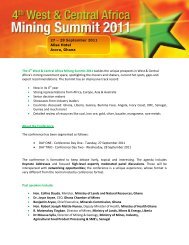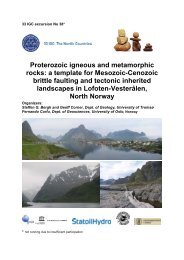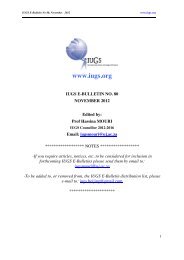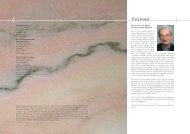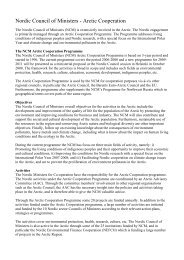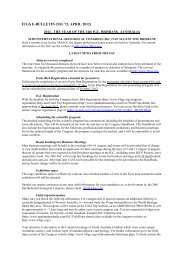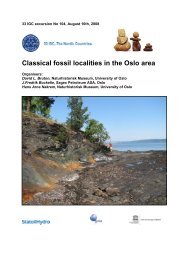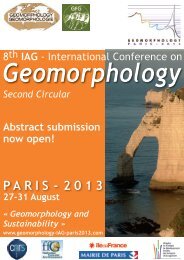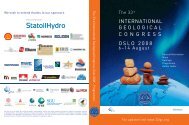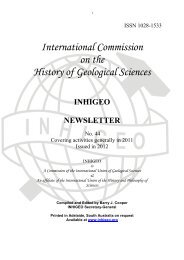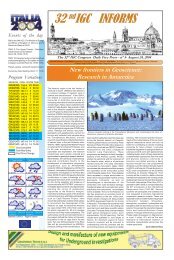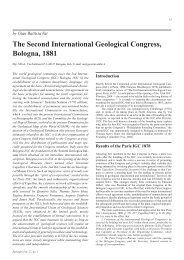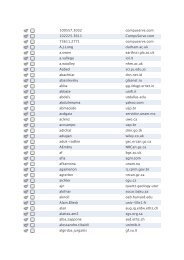You also want an ePaper? Increase the reach of your titles
YUMPU automatically turns print PDFs into web optimized ePapers that Google loves.
Legend: boundaries between thrust sheets (I – III): 1 - established; 2 - interred; 3 - boulders;<br />
4 - pebbles; 5 - gravel; 6 - sand; 7 - clay; 8 - greenish-grey till; 9 - brown till; tectonic faults:<br />
10 - established; 11 - inferred; 12 - foliation; 13 - sites where orientations of pebbles were<br />
measured.<br />
Thrust sheet I is stand out in the section in Fig. 2.20 speculatively and its border is inferred by<br />
the underground waters discharges. The thrust sheet II (Fig. 2.20) is represented by brown<br />
foliated till. The structures of the layering-plastic flow in the basal till, being a flow cleavage,<br />
always dip in the opposite direction of the ice movement (Lukashov, 1980). Relics of the<br />
early paragenesis structural elements are found in the section: a foliated structure dipping to<br />
180°-210° S at an angle of 10-20°. Late paragenesis elements were manifested in foliation<br />
bends resulting in the development of asymmetric folds (with a more gentle western limb); it<br />
is related to the deformation in high-density and high-viscosity rocks, which were almost<br />
frozen. The orientation of early and later paragenesis structural elements is shown on diagram<br />
A, Fig. 2.21. The averages hinge-line is oriented across the ridge morphological axis and<br />
plunges south-eastwards.<br />
Fig. 2.21. Orientations of glaciotectonic structures and pebbles (section of the push moraine<br />
ridge).<br />
Legend: diagram A: 1- maximum of foliation poles formed by shearing; 2 - averaged hinge<br />
line of folds formed by shearing; numbers on the diagram correspond to numbers of sites of<br />
measurements on the section (amount of measurements: in site 1 - 75, in sites 2-5 - 50), a -<br />
early paragenesis structural elements, (b) - later paragenesis elements; diagram B: 3 - poles<br />
of axial planes of folds that deform contacts and layering of the folds, 4 - poles of averaged<br />
hinge line of the folds; diagram С: 5 - poles of shear joints, 6 - their averaged planes, 7 -<br />
major normal stresses in the thrust sheet III; diagrams D and E: long and short axes of<br />
pebbles in site of measurements (site 6 on the section; amount of measurements – 50).<br />
The thrust sheet III (Fig. 2.20) is composed of glaciofluvial and glacial deposits. Its section<br />
illustrated both plicative and disjunctive dislocations. Tectonic faults cut the folds. The folds<br />
were found in the front of the thrust sheet III (Yevzerov, Kolka, 1993); they were of a<br />
complicated shape (Fig. 2.20, in a box) which is possibly due to the influx of material. In the<br />
middle part of thrust sheet III, folds deform the layering and the geological contacts. Axial<br />
poles of fold planes are scattered along the great-circle path, which is common for cylindrical<br />
folds (Kazakov, 1980). On the diagram B (Fig. 2.21), all the poles are practically within the<br />
same plane to indicate that the plicative structures develop in a single field of<br />
paleoglaciotectonic stresses.<br />
Earlier the disjunctive dislocations were investigated. They were represented by various<br />
generations of shear joints (Fig. 2.20). The sequence of joint development was determined by<br />
observations in places where the joints are cross-cutting. Assuming the shear joints to have<br />
30



